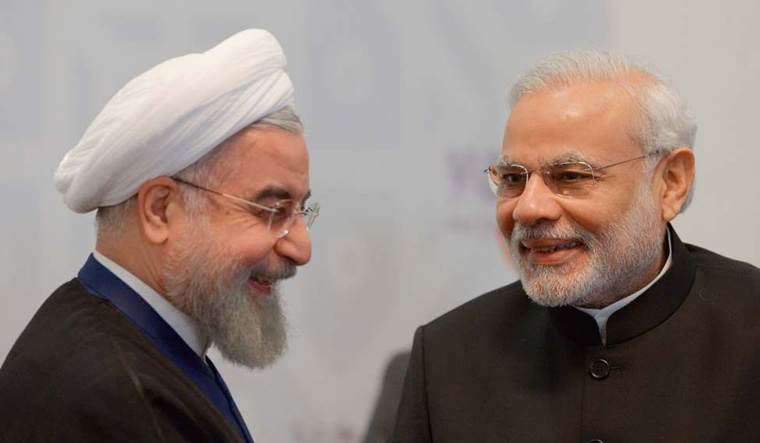India seems to be caught in the crossfire between its biggest trading partner and one of its largest oil exporters. As the United States tries to choke Iran into withdrawing its missile and nuclear programme, India needs to make a tough choice. With the November 4 cut-off date less than four months away, India has to decide whether it can reduce the oil imports from Iran to zero as directed by Washington.
Iran is the second biggest crude oil supplier to India. In 2016, New Delhi had maintained crude oil imports at 2013-14 levels from Iran and even set a target of reducing its energy dependency on Iran from 77 per cent in 2013-14 to 67 per cent by 2021-22.
President Donald Trump announced in May, 2018 that the US was withdrawing from the Iran nuclear deal, formally known as the Joint Comprehensive Plan of Action (JCPOA). The agreement established curbs on Iran's nuclear programme in exchange for sanctions relief. The first set of the newly reimposed sanctions officially came into effect on Tuesday
The withdrawal of the US from the JCPOA impelled Iranian President Hassan Rouhani to reject further talks with Trump unless Washington revokes the deal. Rouhani further likened the US actions to “stabbing in the back” in a televised address as Iran had agreed to curb its nuclear programme in exchange of lifting the international sanctions.
Fine balancing
The history is all too clear. The American administration made allegations against Iran that it manufactured nuclear technology and missiles for clandestine operations and in January 2006, a voting system against Iran was arranged by the International Atomic Energy Agency (IAEA). Subsequently, the IAEA Board of Governors voted to report Iran to the United Nations Security Council, when Tehran ended its voluntary enactment of the Additional Protocol and resumed enrichment of weapons grade uranium. Notably, India had abstained from casting the vote on Iran issue.
The predicament back then was whether India could continue its friendly ties with Iran, at a time when ambitious projects like the Iran-Pakistan-India tri-national gas pipeline were in store. When the Iran issue was put to vote, India had just entered the Civil Nuclear Deal with the US so as to bridge the widening gulf between its energy demand and supply. At a time when the global economy was stifled by the financial crisis and a crumbling world order, New Delhi was torn between choosing a close-ally, and finding a standing on the international arena.
In order to pursue a realpolitik foreign policy, it was argued by the then South Block that, India should stay impartial in the situation. Strong allegations were raised against the UPA–I government led by Manmohan Singh as to whether India’s foreign policy would be directed by the US. However, the Manmohan Singh government was able to balance interests between the US and Iran, prioritising domestic consumer interests and not cracking under duress.
Later in 2015, the Obama administration in the US successfully pressured Iran into the Joint Comprehensive Plan of Action. It had served New Delhi a subtler hint of standing by the US interests unlike the Trump administration, which seems to be aggressively pursuing its corporate agenda.
Challenges ahead
The Modi government’s foreign policy seems to be greatly inclined towards the US interests rather than the national interest and is perplexing in regards to cutting oil imports, which has reduced oil supply and in turn squeezed the pockets of the aam aadmi.
India has invested millions of dollars in the development of Chabahar port in Iran, which provides India strategic access to the Central Asian states, especially Afghanistan.
With the re-imposition of sanctions, Indian businesses will also find it hard to operate in Iran. In the case of setting up of LNG facilities in Iran, Indian firms have been wary of due to American sanctions.
In February 2018, India welcomed the Iranian president in New Delhi. India committed to increase the oil imports by 25 per cent in return for a stake in the Farzad-B gas fields. There are various connectivity projects like the Trilateral Agreement on Transport and Transit Corridor that lie in a sensitive balance which will have to be tactfully maintained by the present government.
There was a glimmer of hope for India in 2015, when the American administration partly withdrew its embargo on Iran. It was hoped that the Modi government would seize the opportunity to invigorate India-Iran oil diplomacy with a renewed stance, but it failed to materialise.
Now with the US taking a U-turn on the JCPOA, the future of India-Iran economic relations, especially the oil diplomacy, lie in peril if India chooses to heed to the “isolate Iran” policy of Trump.
In the current situation, New Delhi will have to undoubtedly run between dialogues with Tehran and Washington D.C. to figure out a benign solution for itself. It is quite unlikely that India will be able to cut the imports to zero in just a few months time.
Currently, the ties between India and the US remain somewhat awkward after the proposed weapons procurement from Russia. With India refusing to cut imports from Iran, it may exacerbate the already strained relations.
However, beyond the geopolitical implications of India’s oil diplomacy, what matters most is India's energy security. India's oil supplies are diversified, but there is still a heavy dependence on petroleum imports. By 2025, it is said to become the second largest pressure on global energy after China. There is a dire need to develop self-sufficiency and reduce oil consumption so as to gain long-term stability in the energy sector. India already has plans to increase its nuclear capacity and expand its renewable sources for energy. At a time when fuel prices are steadily increasing, with the threat of fast receding oil reserves looming large, further development of renewable energy resources could be a crucial step to avert any energy crisis that could essentially cripple the economy.


